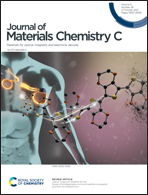Non-fullerene electron acceptors with benzotrithiophene with π-extension terminal groups for the development of high-efficiency organic solar cells†
Abstract
Developing novel building blocks is essentially important to construct high-performance non-fullerene electron acceptors (NFEAs). Benzotrithiophene (BTT) as an electron-donating block has been widely applied in active materials to obtain high-performance organic field-effect transistors. However, its application in NFEAs for organic solar cells (OSCs) has rarely been reported so far. In this work, two NFEAs, BTTBo-4F and BTTBo-4FN, were synthesized by combining BTT as a central unit with two terminal groups. Compared with BTTBo-4F, BTTBo-4FN exhibited stronger absorption, a narrower optical bandgap, and more ordered face-to-face π-stacking. As a consequence, the BTTBo-4FN-based OSCs achieved a higher power conversion efficiency (PCE) of 11.60%, whereas the BTTBo-4F-based OSCs achieved a moderate PCE of 8.27%. Further investigation revealed that the BTTBo-4FN-based OSCs exhibited a more efficient charge transfer, lower charge recombination, higher charge mobility, and better phase morphology than the latter. Our findings indicate that combining BTT as a central unit with π-extension terminal groups is a promising strategy to construct high-performance NFEAs.



 Please wait while we load your content...
Please wait while we load your content...